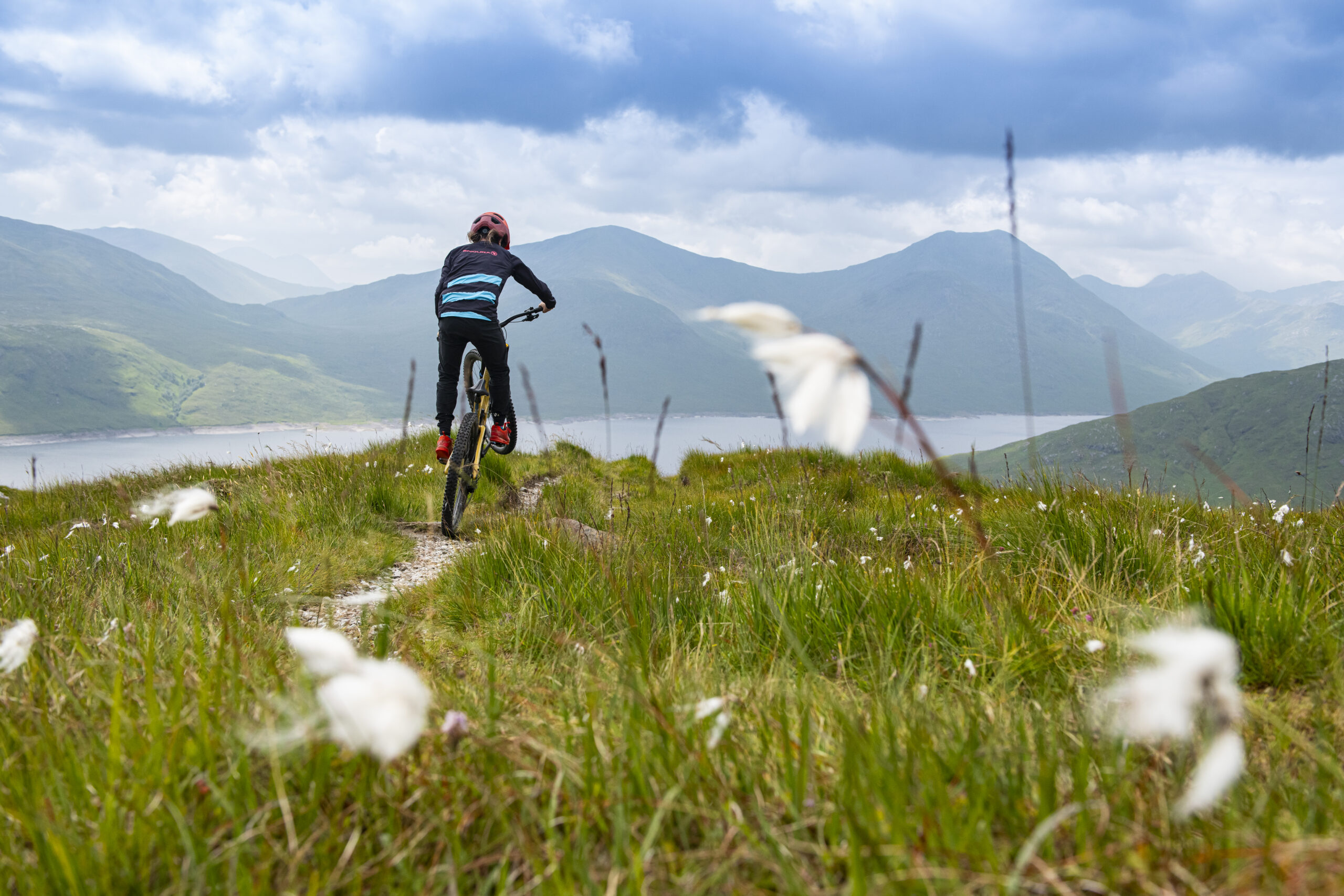
Pete goes in search of the dabs of colour that cling to life in the Scottish mountains.
Words & Photography Pete Scullion
Heading north and west into a little-known corner of the western Highlands, I was off on a solo adventure up a mountain I am very fond of for multiple reasons. First and foremost, this mountain has a 100% eagle record. I’d already seen a sea eagle casting a large shadow on the ground as I wound my way along the old Skye road and, as it turned out, this would be a quarter of the eagles I’d see that day, but 100% of the white-tailed variety. Secondly, if any Purposeful Adventure is to have a reward, then a well-built stalkers’ path that goes over the 800m mark is always going to give you a good return for your efforts. Many moons ago, ghillies carved these wonderful ribbons into the hills to hunt deer and some are still used for this purpose. More often than not they provide the conduit for a seriously good time on a mountain bicycle as their 12 inches of well-drained goodness provides easy passage in both directions. The only downside for anyone who isn’t confident with the bunny hop or the stoppie turn is the proliferation of water bars and very tight switchbacks. Often in unison.

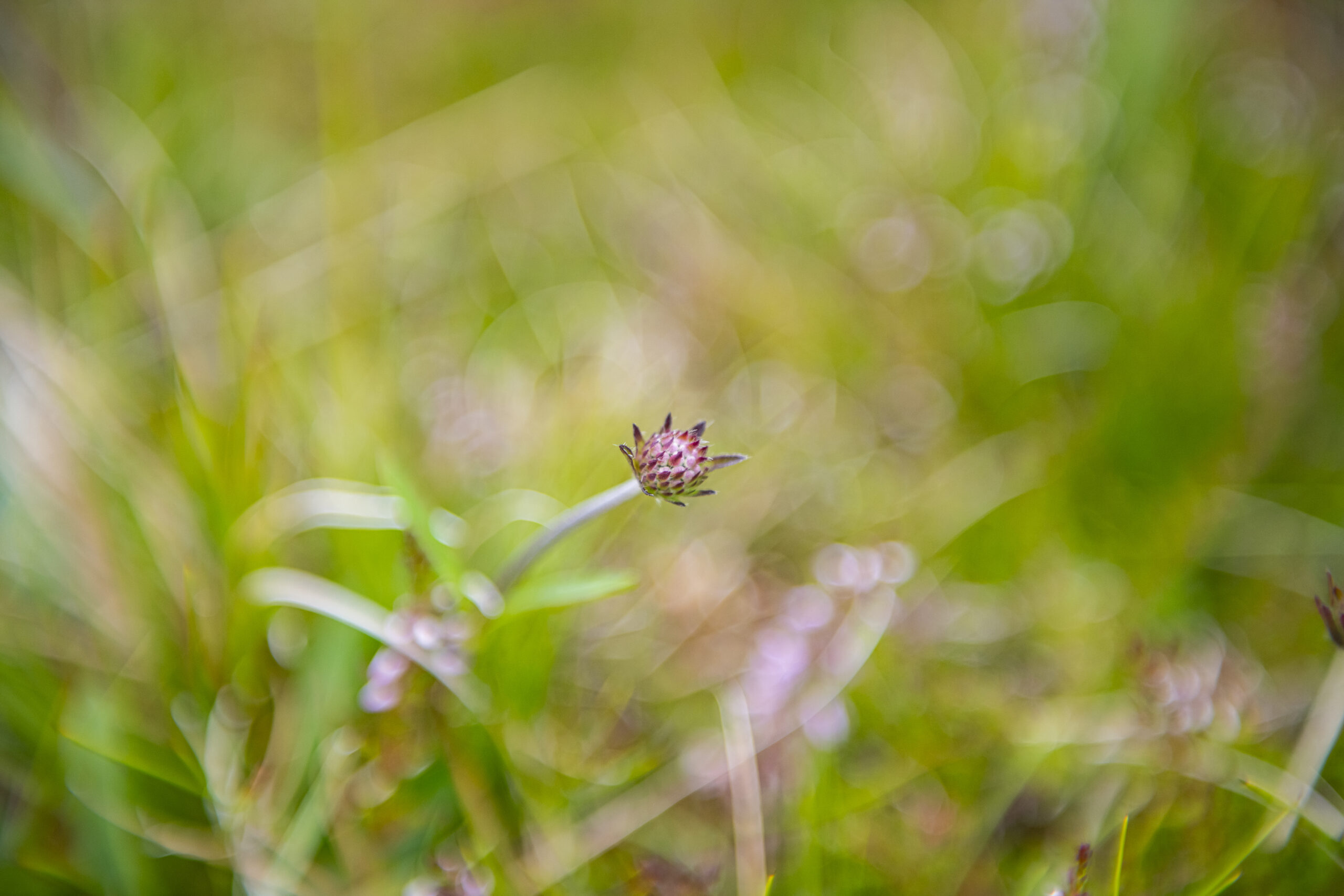

Finally, and the real reason I’m here, is the plethora of flowers that give this otherwise grey and green mountain a splash of colour. Some are present from the road to the summit, others are only present at lower altitudes, and others are higher up. I rode this hill with fellow A-Teamer Rosie Holdsworth some years ago, and our lunch stop atop the earthen shooting embankment was constantly interrupted as we spotted yet another tiny flower barely making it above the dirt. Taking the time to notice and recognise these hardy wee plants will leave you feeling better connected to the hill itself. Plants can help you understand what’s going on beneath your feet too. Some will like it wet with deep soil, or dry soil that clings to a fissure in a small outcrop, while some only grow in certain rock types, usually for the acidity or lack thereof.
Latest Singletrack Merch
Buying and wearing our sustainable merch is another great way to support Singletrack
My chosen mountain would be the Corbett top beneath Sgùrr a’ Mhaoraich, the 881m tall Sgùrr nan Coire Eiricheallach. The name of the taller peak comes from the high mica content of the rock that is made almost exclusively of seashells from when Scotland was at the bottom of the sea and gives the wet rock a magical quality when caught by sunlight.
Seasonal delights
After winding my way along the singletrack road towards Kinloch Hourn, I was finally in the right spot. The stalkers’ path here is slightly overgrown with bracken on the southern slopes, but from there it gives a strong pair of legs an easy route upwards. As I passed under the power lines that somewhat ruin the view east across Loch Quoich, the bracken thinned out and the flowers started to make themselves known.
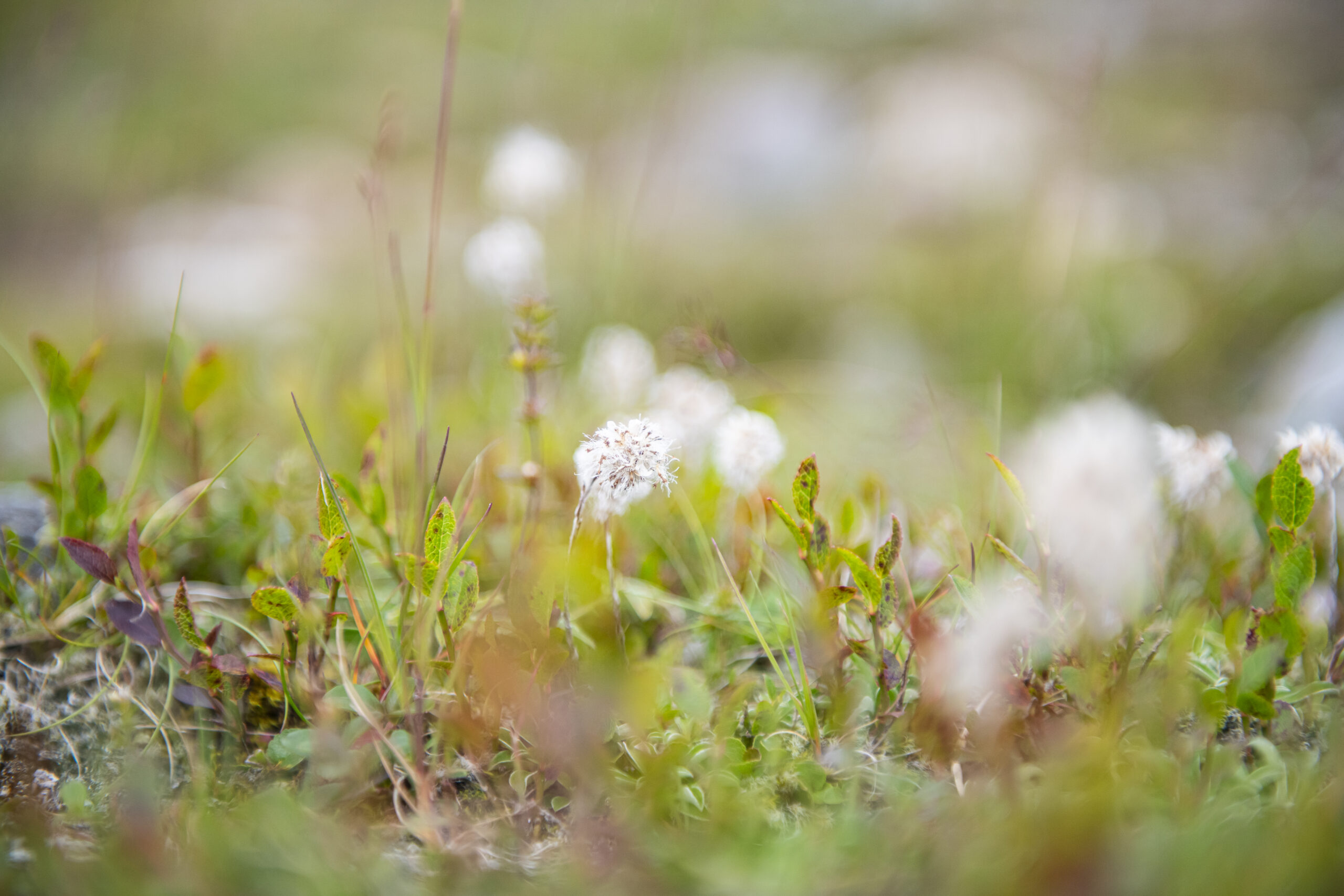
As far as I’m concerned, bog cotton equals summer. On the hill behind my house, these white tufts that dance in the breeze are the imminent sign that 19 hours of daylight is afoot. The southern flank of this mighty Scottish peak is covered in the stuff. As far as the eye could see, the wizards’ beards were at the mercy of the stiff north-north-westerly. I’d have to look a little closer for the rest of the pollen bearers, hidden in the long mountain grass. Almost everything is either a bog specialist or a member of the subarctic club, usually with ‘polar’ or ‘dwarf’ in the name. Nothing really stands more than five centimetres out of the dirt here and many prop themselves up on other plants, or wedge their roots into moss banks or anchor themselves in the crevices of the shattered rock.
With the power lines now below the crest of the hill, the full panoramic view opened up, although, in reality, I was more interested in large birds in the sky or flowers at my feet. One flower that I fell in love with on a post-Fort William World Cup sortie up Càrn Mòr Dearg was the purple saxifrage. A small purple (duh) flower that, on this mighty Munro, carpeted the upper flanks of the hill in a hue of purple I’d never seen before. I was certainly hoping to see some of it on this ride, even if it wasn’t like someone had painted onto the hill with a giant brush.
It wasn’t long before I realised that I’d somewhat failed to recall how long it took me to get to the top last time, and while I was pretty confident that the top was near and around the next corner, I was soon disabused of that notion. No matter, as there was plenty to distract me from my ongoing climb. A good mix of bog cotton, bell heather, bog asphodel and the odd bit of dwarf willow on these lower, wetter slopes. The asphodel was happy in the glistening ground, its bright yellow darts contrasting sharply with the black bog slop.
As I was enjoying a particularly dense patch of these yellow wonders, I looked up, only to see two golden eagles with a stiff wind at their backs rocket past before turning into the wind and evaporating into the heavens. Rarely have I seen a bird gain so much height so quickly…
Mountainside apothecary
By this time I was approaching the earthen embankment that Rosie and I had sheltered behind to refuel and I thought it best to do the same here – though it wasn’t cold, there was no shelter between here and my summit for the day. It was here, just over the 700m mark, that I noticed a bog bilberry that could only muster a single flower and, therefore, a single blueberry. I am a massive fan of plants that will grow regardless of the conditions – give them a chance and they will do their thing. This one blueberry stood in defiance of the grim winter and spring we all endured – and at 700m up a mountain – I can only imagine what effort it took to produce that single piece of fruit.
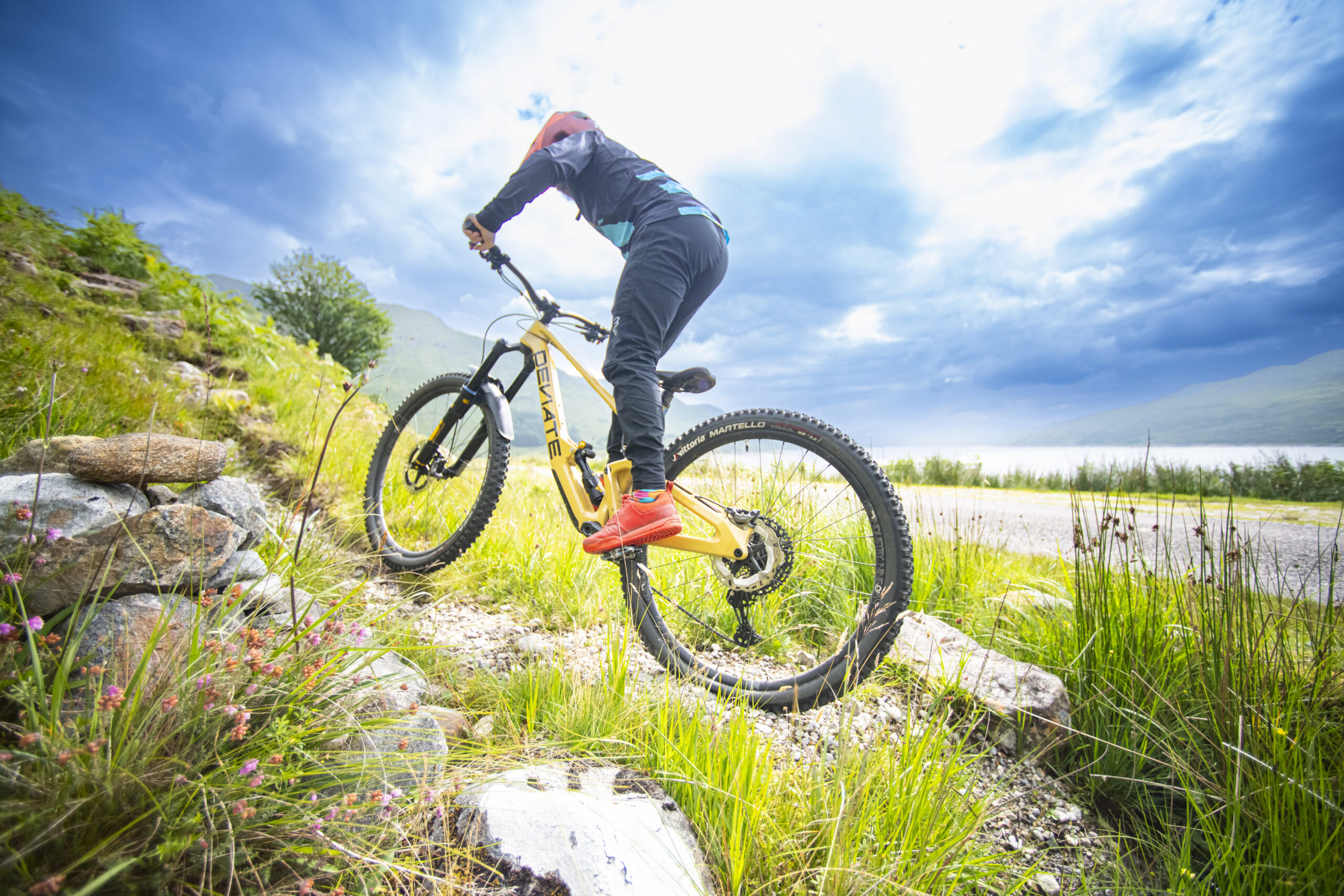
Almost as if turned off with a switch, the stalkers’ path ends at the same time any modicum of dirt or soil. Bare rock and its constituent parts remain. Lady’s mantle, purple saxifrage and dwarf willow cling to the rocks here. Where any liquid is present the asphodels pop too. These yellow delights will grow in anything wet up to 1,000m. Needless to say, you’ll see a lot of them in Scotland.
Many of these particular mountain plants have been found to have uses that the regular mountain goer wouldn’t even think of, and are likely replaced by alternatives in the modern world. Shetlanders have, it’s said, used bog asphodel as a replacement for saffron, and as a hair dye. It’s highly unlikely that any Scottish peak will be the right growing conditions for saffron any time soon. Bog asphodel is also known as the bone-breaking flower, due to its prevalence in low calcium soils that would lead to weak bones in sheep.
Lady’s mantle is known for being a good herbal tea and it can treat a wide array of gynaecological conditions. Its many uses include, but are not limited to, a mild astringent, an anti-inflammatory, antidiarrheal, diuretic, menstrual cycle regulator, a treatment for digestive disorders, and as a relaxant for muscular spasms.
Further afield, in the Nunavut, north of the Northwest Territories, the Inuit use purple saxifrage petals to make tea. Being the first of the spring flowers and one that blooms all summer, it is in plentiful supply for much of the lighter months. The plant can still be used to make tea even after the flowers have died.
Mood-lifting highs
Finally, the summit push is in sight and all I’m left with is thin grass, the odd bit of dwarf willow and pink star heather. Not an eagle in sight sadly. It feels as though I can see all of Scotland from this vantage point. I’ve the best part of 700m of vertical descent to come and it’s easily one of my favourite descents out there. It’s also a treat to see there is nothing on this hill other than tonne bags left when the drainage bars and path were getting shored up. There’s not much I can do about them, seeing as they’re still half full of rocks in some cases. The only thing drifting on the wind here is the seed heads of the bog cotton doing their thing.
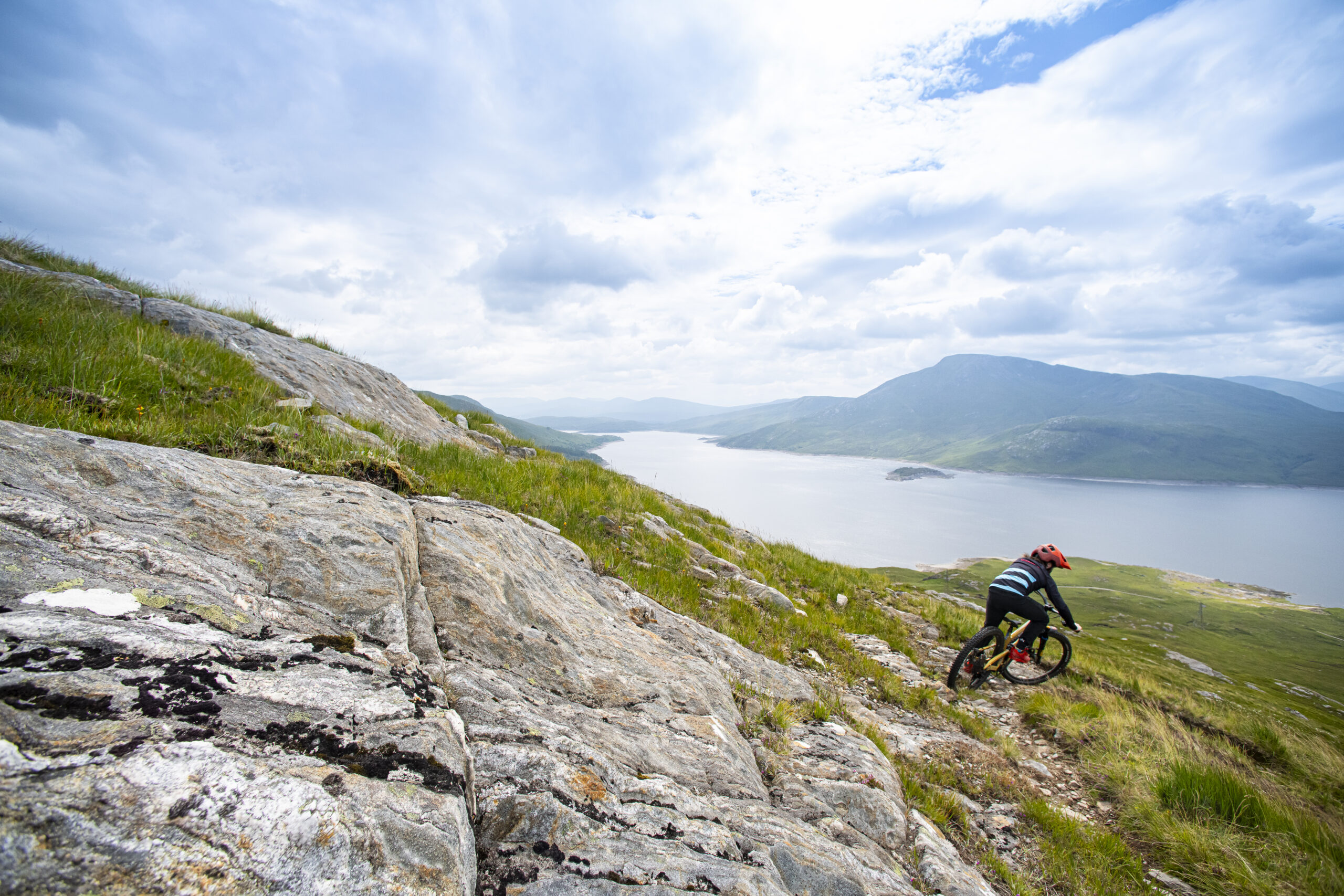
From here, it’s simply a case of winding up the bike and letting it go. There are only a few switchbacks on this hill, but the ones that are there can catch you out if you arrive into them a little too hot. I’ll be honest and say that I was definitely not mountain fit for this day, especially on the descents weirdly enough. My hands and feet started complaining early on and it was simply a case of ignoring them as best I could and cracking on.
It never ceases to amaze me how quickly you can lose your height on a modern mountain bike. I stopped to get the blood back in my hands and feet, looked up and I was at the power lines once more. The intervening few minutes had been a pure focus on staying on track and not losing the wind from my wheels on the drainage bars that came and went. Before long I was spat out onto the road above the sprawling loch, hands and feet offering that sting that indicates you’ve given it a good old go.
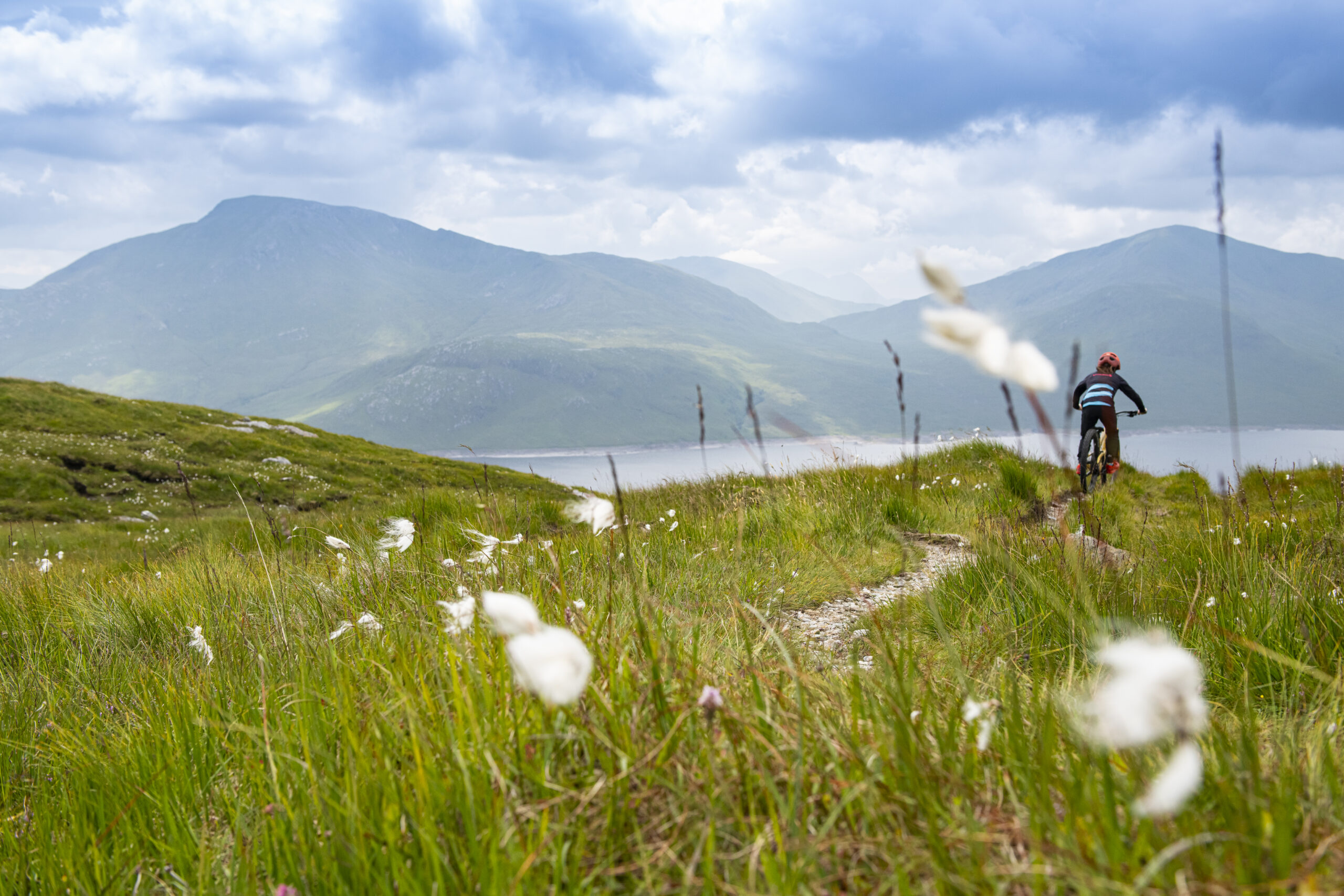
Even if you’re out doing something rad like shoving your bike up a big old Scottish lump, there’s plenty to connect you to the place you’re in. In many cases where grazing animals are thin on the ground, a close look at what’s around your feet will show you some serious colour. No, they might not be a carpet of bluebells or daisies, but those have it easy. Go doff your cap to the flowers that eke out their existence in the higher places.
What is a Purposeful Adventure?
What if our adventures not only sustained us and our connection to nature but actually contributed towards a positive impact on the places we visit?
That’s why Trash Free Trails is encouraging you to embark on a Purposeful Adventure and take some hands-on action to preserve and enhance the environment that nurtures you. That doesn’t mean your adventure should shun your personal enjoyment.
Choose something that motivates and excites you, but think about how you can make a positive impact at the same time. Trash Free Trails will always suggest a trail clean, but it absolutely doesn’t have to be limited to that. A purposeful adventure can be anything you want it to be.

Who are the Trash Free Trails A-Team?
First up, they are riders, runners and roamers just like you. Second up, they are passionate about making a positive impact. They volunteer their time and effort – and more often than not go the extra mile – to represent their trails and the communities who love and use them.
They have pledged to donate their time, passion and talent to protect and promote their trails for everyone to enjoy and we couldn’t be more thankful.
If you’ve got an idea for a trail clean, would like some guidance or just want to find other TRASHMOB members in your area, take a look at the A-TEAM map on the Trash Free Trails website and get in touch with your local representative. They’ll love to have a natter.
